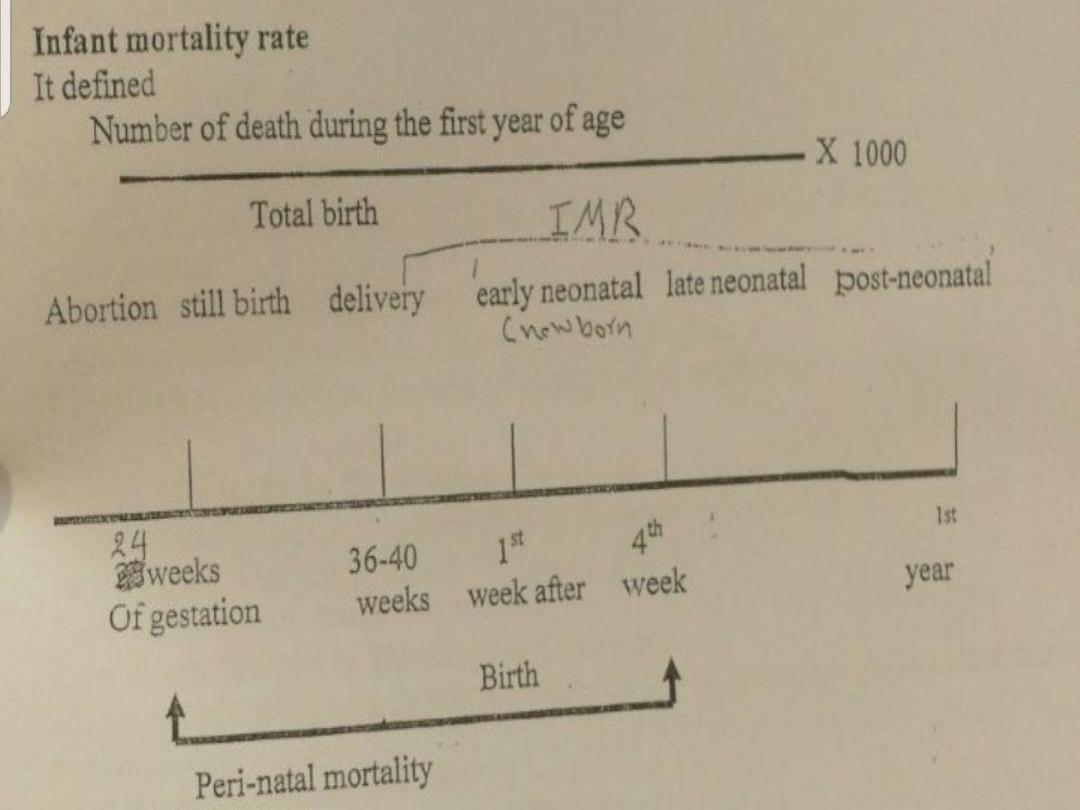

INFANT MORTALITY
Dr.Raad Al.samarraee

Introduction:
Infant mortality refers to the death of an infant
during the 1
st
yr of life.
Number of deaths among infants under 1 yr old
per 1000 live birth in a given year
worldwide,
approximately 10 million infants; more than 90% of
these infants death occur in developing world. In
poorer countries, estimated10-20 % of all infants
die before their 1
st
birthday. IMR became a sentinel
index for the health status of the population.

Infant Mortality Rate (IMR):
is the number of resident newborns in
a specified geographic area (country, state,
county, etc.) dying under one year of age
divided by the number of resident live
births for the same geographic area (for a
specified time period, usually a calendar
year) and multiplied by 1,000.


Infant mortality in Iraq:
1960s 140/1000
1980s 70/1000
1990s 27/1000
1999 108/1000

Causes of decreased infant mortality:
1. improved social status
2.immunization program
3.antibiotics
4.contraceptive


Causes of perinatal death :
1. maternal age: (< 15 , >35 )
2. parity: ( primiparus and > 5 )
3. low social class
4. illegitimacy
5. smocking
6.others: e.g. short stature, congenital
anomalies, anoxia, hypothermia, hypertension
during pregnanacy, low birth wt, birth injury.

Causes of post natal death:
1. infection
2.low social state
3.accident
4.congenital anomalies
5.SIDs(sudden infant death syndrome)
6.preterm birth\low birth wt
7.problems related to maternal complications
during pregnanacy

Infant mortality in developing countries:
Approximately 2/3 of the 10 million child deaths
in developing countries could be prevented with
existing knowledge and treatment.


Terms:
Post term: Infants born from the beginning of the
1
st
day of the 43th wk of gestation onward.
Normal birth wt: birth wt more than or equal to
2500 grams.
Low birth wt: birth wt less than 2500 grams.
Very low birth wt : birth wt less than 1500 grams.

Fetal death:
The death of a formed fetus is one of the
most emotionally devastating events for parents
and clinicians. With improved care for conditions
such as Rh incopatibility, diabetes, and
preeclampsia, the rate of fetal death in the
United States decreased substantially in the mid
twentieth century. However, the past several
decades have seen much greater reductions in
neonatal death rates than in fetal death rates.

As such, fetal death remains a significant and
understudied problem that now accounts for almost
50% of all perinatal deaths.
Risk factors for fetal death include:
- African American race,
-advanced maternal age,
-obesity,
-smoking,
-prior fetal death,
-maternal diseases, and
-fetal growth impairment

There are numerous causes of fetal
death, including
-genetic conditions,
-infections,
- placental abnormalities, and
- fetal-maternal hemorrhage

Low birth wt infant in developing countries:
Higher rates of LBW primarily due to intrauterine
growth restriction(IUGR) rather than preterm birth.
Most important determinants are:
1.low energy intake\low gestational wt gain
2.low prepregnancy body mass index
3.short stature
4.primiparity
5.pregnancy- induced hypertension
6.smocking

Perinatal Mortality :
There is an inverse relation of perinatal
mortality to body wt, as perinatal mortality
decrease sharply when the birth wt increase.


Prevention of infant mortality:
-vaccines
family planning,
-
-folic acid supplement
- drug information
-maternal disease management,
-smocking cessation
,

-maternal medication management
infant medication management,
-
- safe sleep,
-breastfeeding ,
-syphilis screening and treatment
,

-antibiotcs,
-zinc,water sanitation,
-antenatal steroids,
-kangaro mother care,
-detection and treatment of breech
position
.

